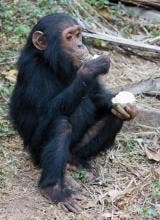Now, I’m not advocating alcohol consumption, but truth be told most of us take alcohol for granted, and I’m not referring to abusing either. Millions of years ago, our ancestors and primate relatives had a very poor ability of metabolizing ethanol — the alcohol in beer, wine and spirits — and were it not for their pioneering “work”, we humans might have not been able to enjoy alcoholic spirits the way we do today.
Chemist Steven Benner of the Foundation for Applied Molecular Evolution in Gainesville, Fla believes that our first ancestor capable of metabolizing ethanol may have lived 10 million years ago, after him and colleagues reconstructed alcohol-metabolizing enzymes of extinct primates.
To break down ethanol, humans like most primates use an enzyme called alcohol dehydrogenase 4 or ADH4, for short. Since the enzyme is fairly common through out the esophagus, stomach and intestines, it is the very first line that meets alcohol when a person drinks, and thus is the most important component in breaking down ethanol. However, not all primates have the same working ADH4, as some can’t even effectively metabolize ethanol – poor fellows.
Alcohol consumption: a tradition worth million of years
The researchers analyzed the stretches of DNA referring to ADH4 in 27 modern primate species, including lemurs, monkeys, apes and humans. In the meantime estimates of extinct primates’ enzyme genetic code was made; enzymes that were then rebuilt in the lab and analyzed in order to gain a better understanding of how these work. Equipped with this new found data, the researchers mapped the DNA sequences on a primate family tree in order to see how the genes changed in key points of the tree, like the branching points, typically corresponding to extinct primates.
Their results show that most primate ancestors wouldn’t have been able to metabolize ethanol, however at a certain branching point that lead to the evolution of modern day primates like gorillas, chimps or humans – corresponding to an ancestor that lived roughly 10 million years ago – the enzyme became capable of digesting alcohol. The jump is rather staggering since the enzyme is believed to have been 50 times more efficient than those in earlier ancestors.
Obviously, a catalyst was required and the scientists hypothesize that it was during that time that our tree dwelling ancestors began to explore the ground level more. It is here they might have found fruit fallen from the trees that fermented its sugars into ethanol. Individuals that could metabolize the alcohol in these fruits better than those who didn’t had a better chance at surviving, and thus the enzyme became stronger in generations to come.
But it may be too soon to link metabolizing ethanol with living on the ground, said Jeremy DeSilva, a biological anthropologist at Boston University. “There’s very little fossil evidence from the general time period when humans, gorillas and chimpanzees last shared a common ancestor.”
Benner exposed his idea during a talk at the recent American Association for the Advancement of Science annual meeting. In the meantime, I can’t help myself posting this incredibly hilarious video that shows what effects alcohol has on primates and other animals. Not surprisingly, they don’t behave too differently from our own human debaucheries.










